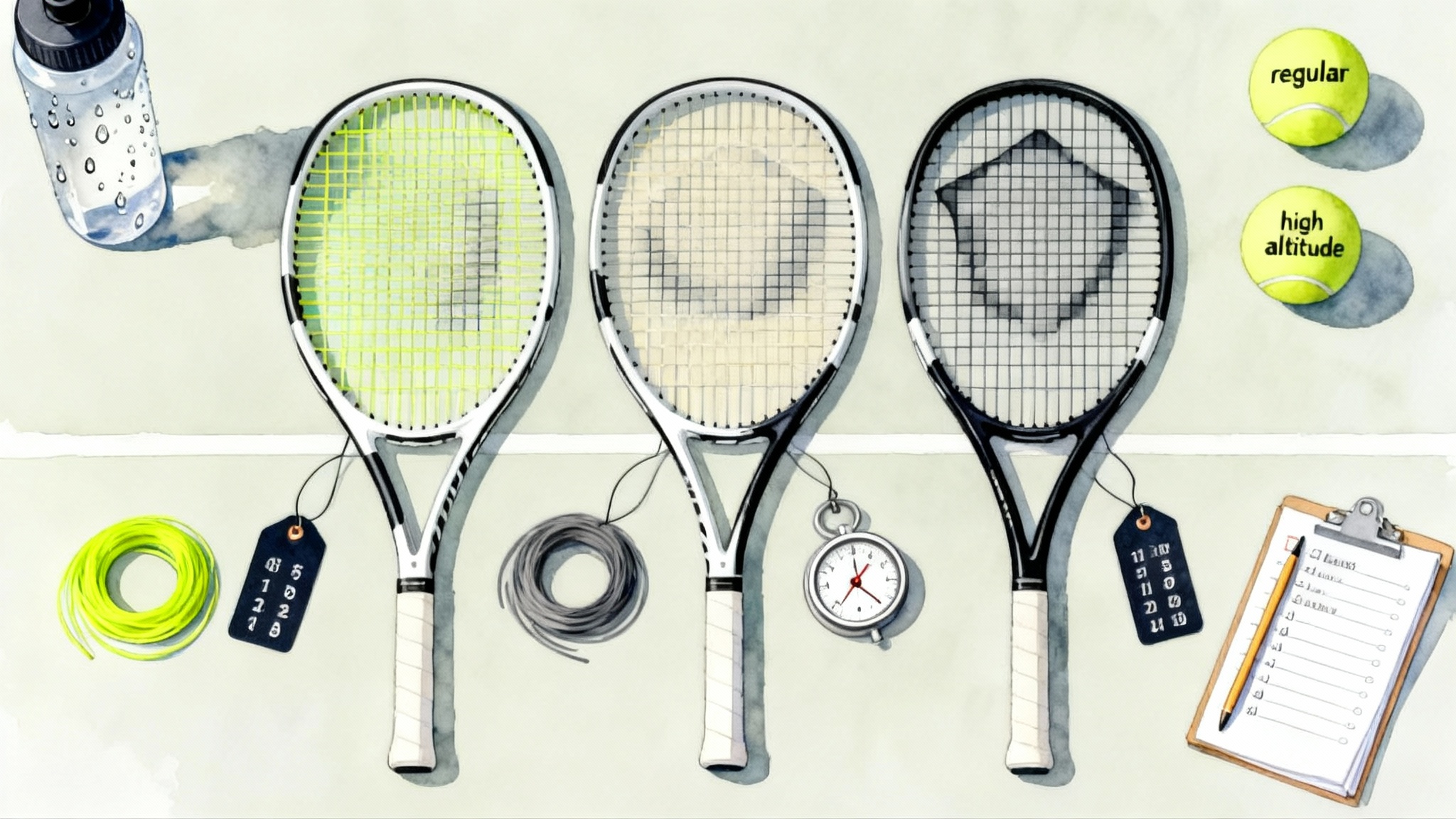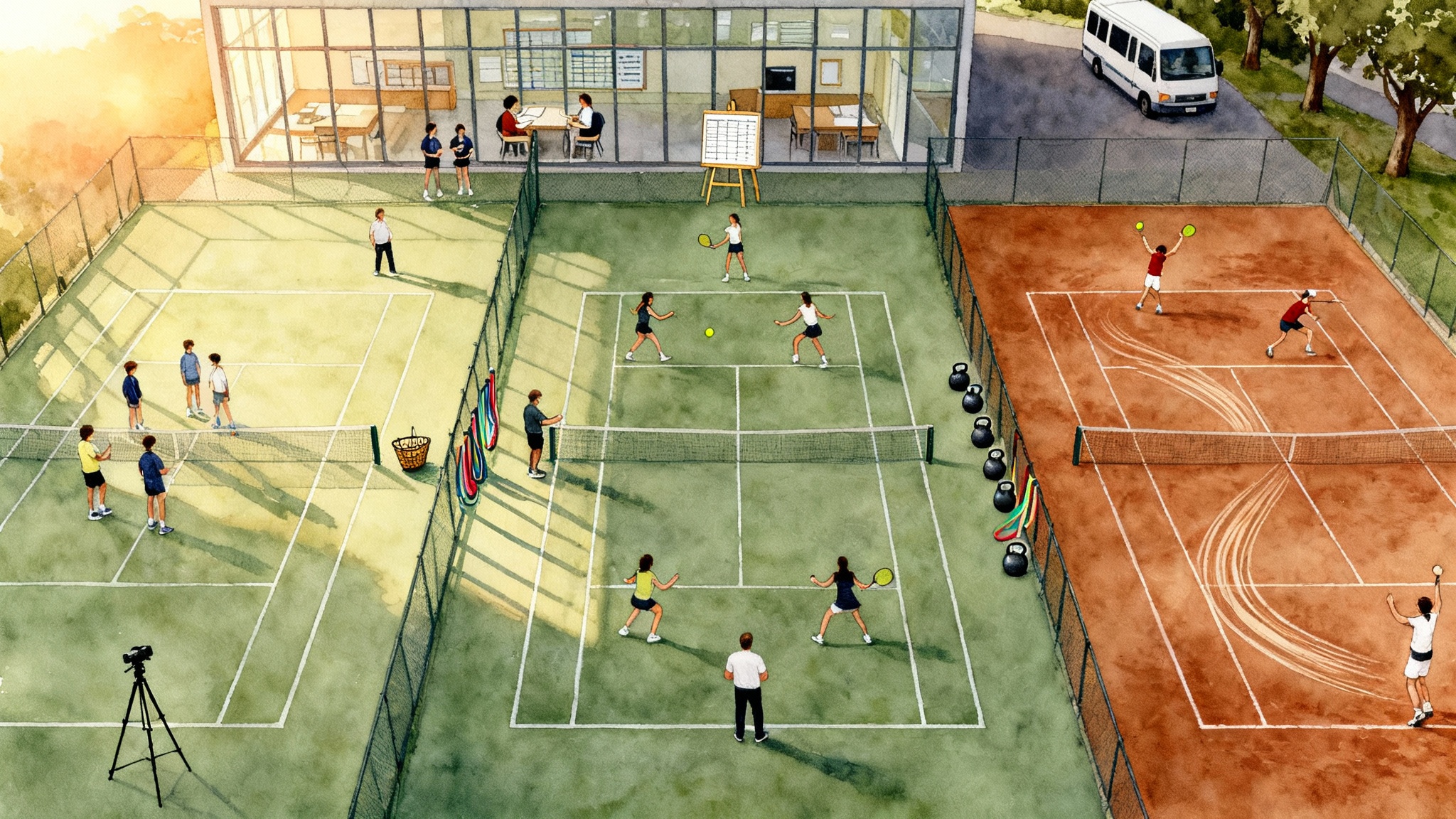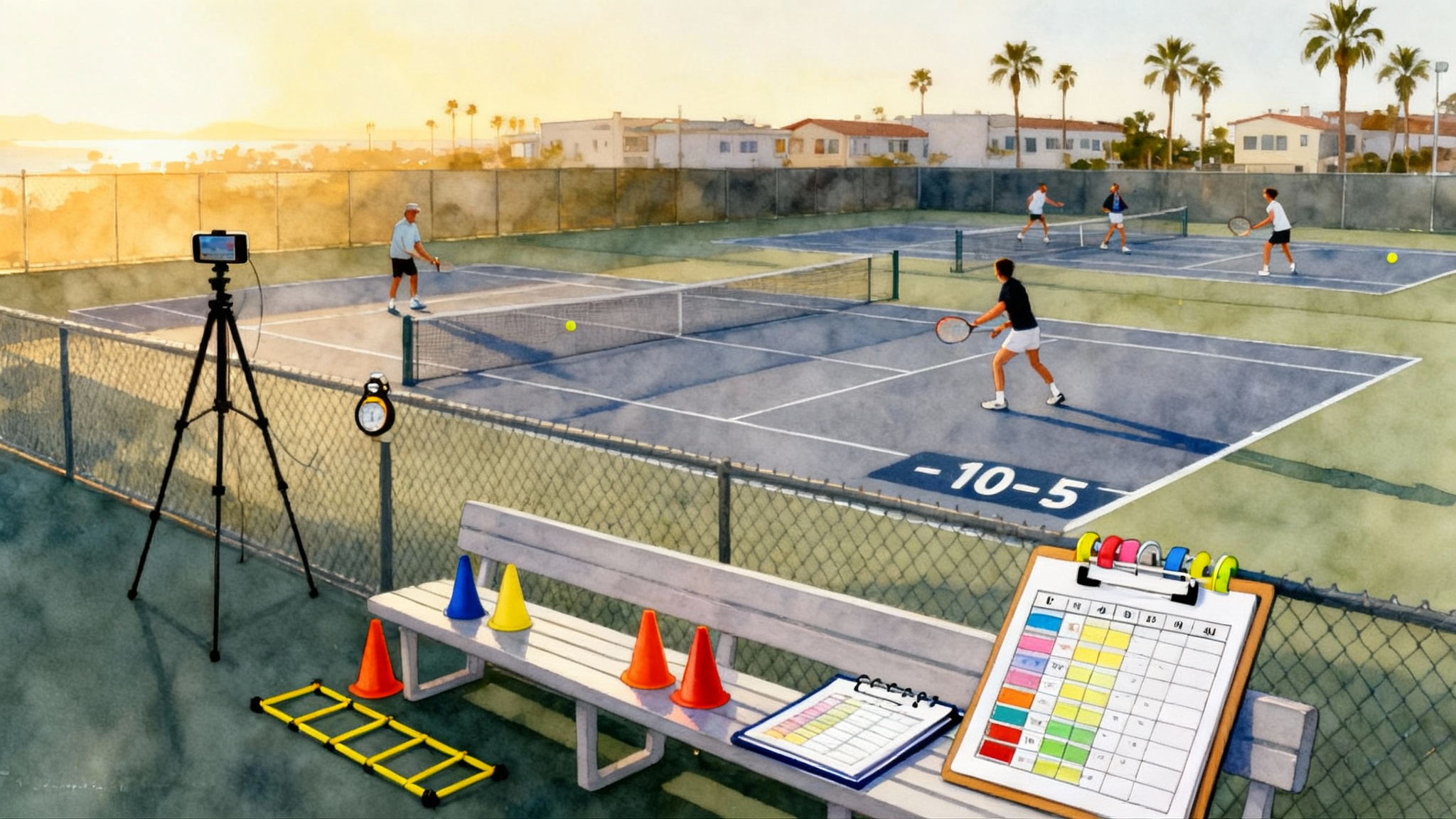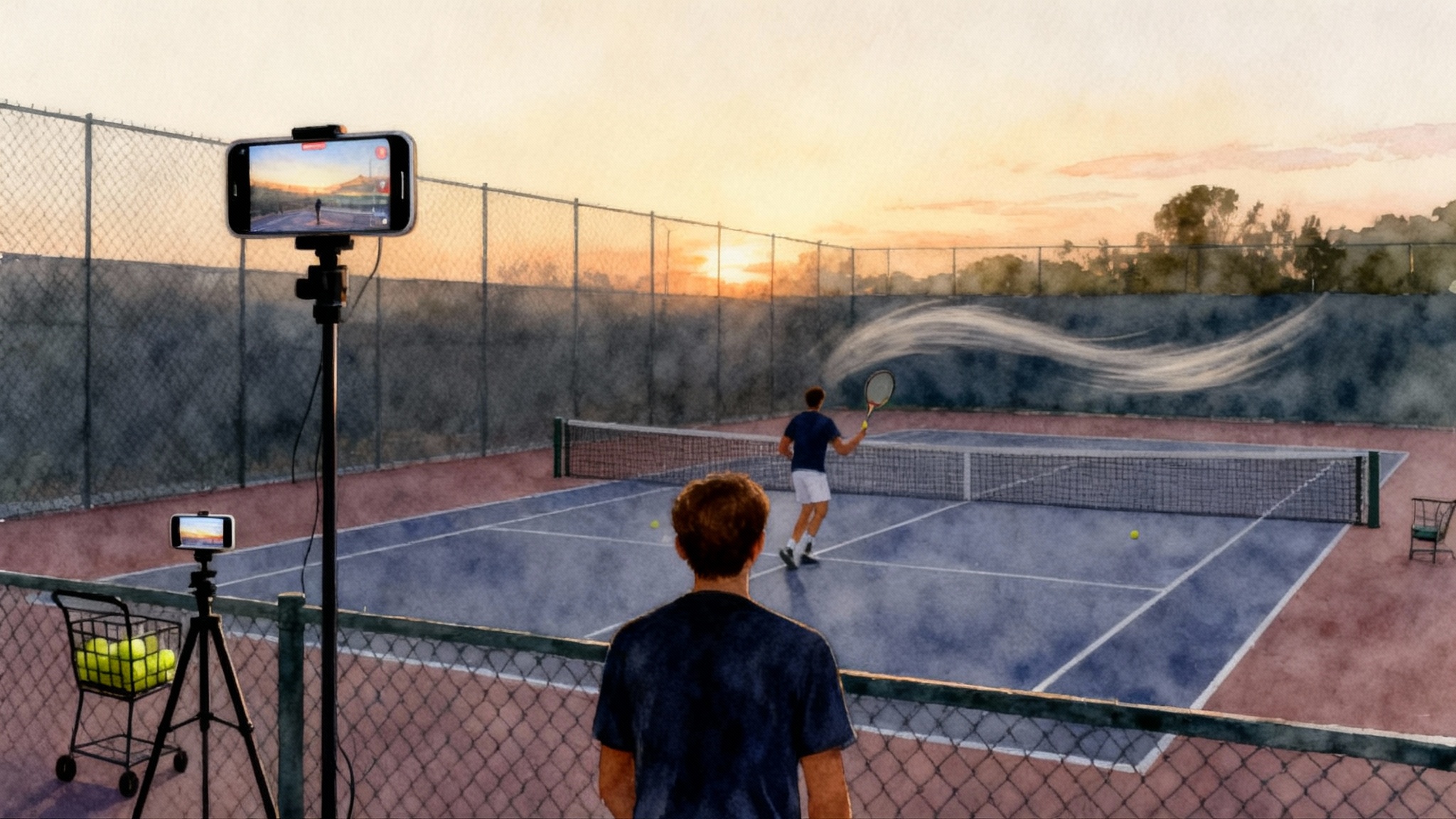First Four Shots: Win More Tennis Points With Smart Starts
Most rallies end quickly. Here is how to own the first four shots with clear patterns for serve, return, and the next ball, plus drills and simple tools that build pressure-proof starts for players of every level.

The stat that changes how you practice
Ask ten players what decides a point and you will hear long answers about fitness, grit, and endless rallies. Watch serious match data and a quieter truth appears. A large share of points finish in the first four shots: serve, return, server’s next ball, and returner’s next ball. When the opening pattern is clean, the rally often never begins. When it is messy, you chase for the rest of the game.
This article shows you how to own those first four shots. You will build simple patterns for serve and return, stack them into point plans, and practice with games that reward fast, correct choices. You will also see how to use common tech like phone video and consumer ball machines to hardwire the skills.
The framework is simple:
- Shot 1: Serve or return
- Shot 2: The plus-one ball for the server or the returner
- Shot 3: The reply that either finishes or stabilizes
- Shot 4: The confirmation shot that seals control or resets to neutral
Control the first four and your service holds rise, your return games gain traction, and you stop donating cheap errors.
Build your point in phases
Think in three phases, like a sprinter leaving the blocks.
- Launch: explosive, planned, and precise. This is the serve or the return. The goal is not highlight power. The goal is to start on your terms.
- Shape: the plus-one shot. This ball steers play into your favorite space. It is the most important forehand you will hit all day.
- Close or cage: finish the point if you earn a sitter, or create a safe cage that squeezes the opponent into an error without taking wild risk.
When you map your habits to these phases, patterns become obvious. If your return floaters drift to the middle, your plus-one reply is always late. If your serve climbs too high, the first ball comes back on your toes. Fix the first steps and the last steps get easy.
Serve priorities that travel under pressure
A good serve is measured by how easy it makes your second shot. Use this three-part checklist.
- Height: clear the net by a safe window. Think the height of two tennis balls over the tape for first serves you want to land heavy. Less for slice out wide. The test is repeatable arc, not a flat laser that only works on a good day.
- Direction: pick a lane before the toss. Hoard your misses toward your target. If you aim body, a slight push wide is fine. A pull into the opponent’s strike zone is not.
- Spin: add enough spin that your margins grow when nerves hit. Spin is not slow. Spin is control of curvature.
Your serve target menu should be small. On the deuce court, build two core serves that you trust: body slice and wide slice. On the ad court, learn a kick up the backhand and a body serve that jams. You do not need an ace. You need a predictable reply that your plus-one forehand loves.
The plus-one forehand plan
Picture a funnel that begins at your serve and narrows to a forehand in the middle third. That is the plus-one plan. Two practical patterns work for nearly everyone.
- Deuce court, slice body serve: expect a blocked return to your forehand. Hit plus-one to the opponent’s backhand deep and heavy, then step inside the baseline.
- Ad court, kick backhand serve: expect a high, slow return. Take it early to the open deuce court and recover forward, not backward.
If you are a lefty, flip the patterns. If your backhand is your best shot, your plus-one can be the backhand into the opponent’s weaker wing. The principle is the same. Serve to a place that gives you your favorite next ball.
Return priorities that strip the server’s plan
On return, you do not need winners. You need a neutral ball that rejects the server’s funnel.
- Contact point: meet the ball in front, even if that means a shorter swing. Your eyes track the ball, not the server’s motion.
- Target: high, crosscourt, deep. Crosscourt gives you more court and more net clearance. Deep makes the plus-one harder for the server.
- Shape: slight topspin or a firm block. Keep it low on body serves. Float it higher on wide kick serves to buy time.
Treat second serve returns as a green light. Step in. Take the ball rising. Choose a big target and aim through it. The goal is to make the server hit a defensive plus-one from an uncomfortable position.
The return plus-one plan
Once the return lands, expect a rushed reply. Be ready with one of these.
- Middle squeeze: send your next ball hard through the middle third to remove angles. This buys time and denies the server a counter.
- Wide cage: if the server floats a short ball, go heavy and wide, then follow your shot inside the baseline. Finish on the next ball or keep them wide until the error comes.
Pattern library for common player types
You do not need ten plays. You need two reliable plays on each side that you can repeat and disguise.
Baseliner who favors forehand
- Serve pattern A: deuce slice body, plus-one forehand deep to backhand, then forehand inside out. If short, approach down the line.
- Serve pattern B: ad kick to backhand, plus-one forehand crosscourt, then forehand inside in for the finish.
- Return pattern A: backhand block crosscourt, plus-one forehand to the middle, then forehand heavy to the weaker wing.
- Return pattern B: forehand chip middle, plus-one backhand crosscourt, then take forehand on the rise.
All-court player who loves the net
- Serve pattern A: deuce wide slice, plus-one approach to backhand, volley to opposite corner.
- Serve pattern B: ad body, plus-one drop shot or short angle, look for the floating pass and close with the volley.
- Return pattern A: blocked return deep middle, plus-one approach to the open court.
- Return pattern B: chip low crosscourt, follow to the service line, and finish with a first volley into space.
Left-handed server
- Serve pattern A: ad wide slice that drags the opponent off the court, plus-one forehand to the open deuce side.
- Serve pattern B: deuce body into the right hip, plus-one backhand to the backhand corner, step in.
- Return pattern A: forehand block back through the middle, plus-one forehand inside in.
Build these into your match routines. Write them on a small card in your bag. When the set gets tight, you will not guess. You will run your plays.
A simple scoring system that rewards fast control
Most players scrimmage with standard scoring, which does not reward the specific behavior they want to learn. Use games that pay you for early control.
- Four-shot capture: any point won within your first or second shot earns two points. Any point won after that earns one point. First to 15.
- Plus-one challenge: server only scores if the serve lands in the target box and the plus-one lands past the service line. Returner scores for deep crosscourt returns and a solid next ball. Switch every two serves. First to 11.
- Second serve pressure: server must hit second serves for the whole game. Returner earns two points for a deep crosscourt return, one point for any other neutral return. This rewires your brain to love second serve returns.
These games shift your focus from outcome to process. You begin to crave depth on returns and height on serves. That is the correct craving.
Drills that hardwire the first four shots
Serve plus-one cone course
- Place three cones just inside the baseline in the ad court, and three in the deuce court.
- Serve to your chosen target. Coach or partner feeds a simulated return to your forehand. You must hit your plus-one into a cone lane.
- Scoring: 1 point for a serve in, 1 for a plus-one into the lane, bonus point if you finish the third ball aggressively and in.
This drill trains placement under a shifting timeline. You learn to move from the serve into a balanced first groundstroke without rushing.
Return cage builder
- Partner serves at seventy percent. Your return must land deep crosscourt past a backline marker. The next ball must go middle third, belt height. Your fourth ball must go heavy to the weaker wing.
- Scoring: two points for a three-ball cage. Reset if you miss depth on the return.
You build the habit of removing angles. The server feels trapped, and you feel calm.
Two-bounce box for nerves
- Draw a rectangle three feet inside the baseline and as wide as the singles court. This is the safety box.
- For ten minutes, every plus-one ball must bounce twice inside the box before you can hit a finishing shot.
This forces spin and height. When stress rises in a match, this discipline protects your lead.
Doubles first-four ladder
- Team A serves two balls each, rotating sides. Team B returns with the goal of hitting a playable return that lands past the service line. If they do, they get a climb point. If Team A finishes within four shots, they get a climb point. First team to the top wins.
Doubles points are even shorter. Owning the first volley and the first return is everything. For more patterns and formations, see the college-ready doubles playbook.
Troubleshooting the first four
If the plan makes sense yet the errors remain, find your bottleneck.
- Toss drift: a wandering toss destroys direction. Stand with your toes on a line. Catch ten tosses without swinging. The ball should drop inside your front foot every time.
- Late split step: if you feel rushed on plus-one balls, your split step is late. Start your split as the opponent begins to swing, land as the ball leaves the strings.
- Shallow returns: the difference between neutral and defensive is two feet. Set a backline target with tape. If you cannot clear it, shorten your swing and add height.
- Overheating short balls: the first short ball is not an invitation to blast. Send it deep to a big target and close forward, then finish the next one.
How to customize by surface and opponent
- Hard courts: the ball comes fast. Favor body serves that jam and returns to the middle third. Aim for chest-high plus-one contact.
- Clay: the ball sits up. Use kick serves that push the returner back. On the plus-one, send heavy crosscourt to create height and time.
- Grass: points are brief. Practice low slice returns and wobbly, skidding serves. The plus-one is often a short approach and a first volley, not a full swing.
Against big servers, make the return plan even simpler: chip low crosscourt and recover diagonally forward. Against counterpunchers, expect one more ball back and plan to confirm with your fourth shot to the big target again. Against net rushers, hit the return at the feet and prefer the lob confirm on your fourth shot rather than a thread-the-needle pass.
Smart use of technology, not a shopping spree
You do not need a stadium budget to measure the first four shots. A phone on a fence mount records at sixty frames per second. Ball tracking systems at major events use advanced tools to chart rally length, but your version can be simple and useful.
- Shot charting: after a set, mark a paper grid with S for serve targets and R for return targets. Circle any point you ended within four shots. Patterns will jump out.
- Video checkpoints: pause after the serve to check balance and front-hip position. Pause on the return to check contact in front and follow-through height. For a step-by-step setup, use our DIY tennis video analysis checklists.
- Consumer tools: a compact ball machine or a programmable unit can feed the same ball over and over, which is perfect for plus-one rehearsals. Video analysis apps let you draw contact zones and compare swings side by side.
Keep the tech servant mindset. You are not trying to collect content. You are trying to remove one leak at a time.
A between-points routine that protects your plan
The best patterns fail if your mind races. Use a short routine after every point.
- Reset: turn away from the court for two steps and unclench your jaw. Exhale.
- Recall: say the next pattern quietly. Deuce wide slice, forehand to backhand. Or return crosscourt deep, middle cage.
- Rehearse: one shadow swing for the plus-one. Feel the target, not the power.
- Ready: look at your strings, then the target area, then the ball.
This costs six seconds. It prevents the two double faults that appear from nowhere and the quick miss off a short return.
What to measure each week
Improvement requires a scoreboard. Each week, track three numbers.
- First serve to target percentage: pick one target on each side and count how many out of twenty land in. If you are under twelve, lower your speed and raise your arc.
- Deep return percentage: count how many returns out of twenty land past your backline marker. If you are under ten, start your return from one step farther back and shorten your swing.
- Plus-one success rate: serve or return, then mark whether your next ball landed in your planned target with depth. Aim for sixty percent or better.
To lock these habits into your weekly plan, use these smart tennis week templates.
Your long term goal is boring consistency. Boring wins. Flashy is for the occasional bonus when the pattern gifts you a sitter.
A quick guide for coaches and parents
- Narrow the playbook: pick two serve targets and two return targets per player for the next month. Only add more once the plus-one lands deep by default.
- Drill with a clock: most junior practices drift into rally contests. Set up constrained games that finish fast and force accuracy early.
- Use video as proof, not opinion: show the player where the plus-one contact happens in space. Draw it. Move a cone to that spot.
Players do not resist discipline when the change is visible and understandable. They resist when coaching sounds like mystery.
Bring it together on match day
Before warmup, write your four patterns on a card. During warmup, test the opponent’s comfort in those lanes. Early in the first game, call the simplest play that fits the toss and the wind. Between points, rehearse the next plus-one out loud under your breath. When momentum swings, resist the urge to play new tennis. Go back to the pattern that you practiced on Tuesday with cones. Trust depth, trust height, and let the first four shots carry your day.
You will still have long rallies. You will still need fitness, grit, and plenty of problem solving. The difference is that you will start points on your terms. And when you start on your terms, you finish more on your terms, which is the quiet math behind confident tennis.
The smart finish
Tennis rewards players who plan the opening like a chess player and execute the first moves like a sprinter. If you simplify your serve and return targets, script your plus-one shots, and practice with scoring that pays early control, your results will shift. Not next year. This week. The first four shots are not a slogan. They are a blueprint. Build yours and the scoreline follows.






